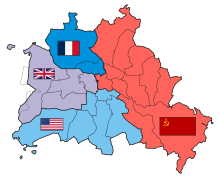Propaganda in East Germany: Difference between revisions
ClueBot NG (talk | contribs) m Reverting possible vandalism by 165.24.201.136 to version by R. S. Shaw. False positive? Report it. Thanks, ClueBot NG. (1566085) (Bot) |
|||
| Line 29: | Line 29: | ||
=== In Society === |
=== In Society === |
||
During the time of the Cold War, society in East Germany was affected by propaganda which endorsed Stalin as a leader of the socialist movement. The socialist movement cultivated a sense of peace and happiness among the people of East Germany along with a sense of community throughout The German Democratic Republic. |
During the time of the Cold War, society in East Germany was affected by propaganda which endorsed Stalin as a leader of the socialist movement. The socialist movement cultivated a sense of peace and happiness among the people of East Germany along with a sense of community throughout The German Democratic Republic. |
||
Am good hybrid pker fam LOL |
|||
=== In Propaganda === |
=== In Propaganda === |
||
Revision as of 17:00, 22 March 2013
After the end of World War II Germany was separated into nation-states. Each nation-state was governed by a different country because officials could not agree on peace terms. The Soviet Union had claimed the eastern portion of the country. In 1947, the "German People's Congress for Unity and Just Peace" met in Berlin. The Congress was to take the demands of all the occupied zones, and create a peace treaty which would enact a centralized German government. In order to have their nation-state properly represented, the Soviets created The German Democratic Republic in 1949 when they officially approved their constitution in May.

Purpose
The purpose of propaganda in the German Democratic Republic was to maintain the Soviet ideology of socialism. Through various forms of propaganda such as posters, pamphlets and speeches the Soviet Union censored the ideas of the allied forces and the outside world from the citizens of Eastern Germany.
Media
Media for East Germany propaganda during the cold war played a very significant role in the persuasion and ideologies of the East German people at this time. The types of media that were most prevalent in their propaganda efforts were posters, pamphlets, tabloids, and speeches.
Posters
Posters during the Cold War focused primarily on depictions of Stalin and his positive effects on East Germany. The information on the posters was used to convince the German people that the institutions of the Soviet Union would perpetuate a peaceful socialist society. Many other posters were used to depict the allied forces in a negative light, this form of propaganda was generated to make the Germans dislike the ally outsiders.
Pamphlets
The German Democratic Republic created pamphlets to promote a socialist and peaceful way of life to those living in Western Germany. These pamphlets were dropped in the Federal Territory of West German zones in large "propaganda rockets" and small "metal coconuts", along with "occurrence reports" that documents the times they were sent and 'outside occurrences' to spread their news in an innovative, creative and far reaching way. The "propaganda rockets" allowed for more people to be exposed the information over a large geographic scale.
Tabloids
The German tabloids during the cold war were used as media source to entertain and inform the working class with pictures, articles and news that highlighted the successes of the East German society. East German Cold War Tabloids & Propaganda
Speeches
There were many influential leaders and intellectuals during the Cold War in East Germany. Speeches were made in order to persuade the people to fall in line with the socialist movement and the leaders of the Soviet Union. These speeches, along with the propaganda aforementioned helped to convince the German people that socialism and the German Democratic Republic would remain intact.
Significance
The propaganda of East Germany during the cold war contributed to the socialist movement which was created by the Soviets before the fall of the Berlin wall. It affected East Germany as a society but also affected German propaganda as a whole.
In Society
During the time of the Cold War, society in East Germany was affected by propaganda which endorsed Stalin as a leader of the socialist movement. The socialist movement cultivated a sense of peace and happiness among the people of East Germany along with a sense of community throughout The German Democratic Republic. Am good hybrid pker fam LOL
In Propaganda
The social implications of East German Propaganda during the cold war lasted and was evident from 1946 until the fall of The Berlin Wall in 1989 when Germany became one.
References
[1] [2] [3] [4] [5] [6] [7] picture link:[8]
- ^ History Channel Online, Cold War, http://www.history.com/topics/cold-war
- ^ The GDR: A State of Peace and Socialism by Erich Honecker, http://www.calvin.edu/academic/cas/gpa/erich1.htm
- ^ Map of Cold War Berlin, Encyclopædia Britannica Online, http://www.britannica.com/EBchecked/topic-art/62055/54542/Map-of-Cold-War-Berlin
- ^ Contra Magazine Tabloids, http://rectoversoblog.com/2010/12/13/propaganda/
- ^ The BIrth of the German Democratic Republic, http://www.germanculture.com.ua/library/history/bl gdr.htm
- ^ The Rise and Fall of the German Democratic Republic 1945-1990 by Mike Dennis pgs. 3-4 published in 2000
- ^ Bye Germany, Hello Wall, http://people.usd.edu/~clehmann/HWB/hwb_n/prewall.html
- ^ http://ajourneyroundmyskull.blogspot.com/2010/12/warm-wishes-from-ddr.html
